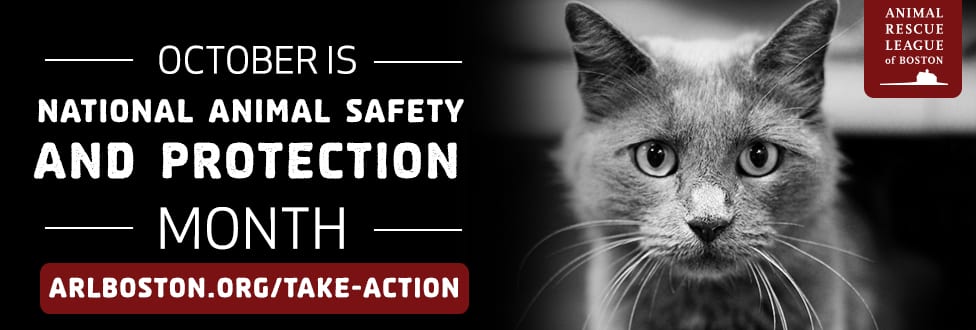If You See Something, Say Something – Report Animal Cruelty!
What you need to know about animal hoarding
In support of National Animal Safety and Protection month this October, the ARL is kicking off its fall “See Something, Say Something – Report Animal Cruelty” campaign.
Animal cruelty comes in many forms, including physical abuse, neglect of basic care, abandonment, dog fighting, and animal hoarding. Because many studies have demonstrated a strong link between cruelty to animals and other forms of domestic and community violence, prevention plays a critical role in improving the safety and welfare of both animals and people in Massachusetts.
Know your state’s animal cruelty laws
This month, we’re focusing on the topic of animal hoarding- an increasingly frequent and challenging issue in Massachusetts. In less than 12 weeks alone, ARL’s law enforcement team assisted in at least 6 hoarding-type cases and removed more than 200 animals from these situations.
Surprised? Unfortunately, there are many more animal hording cases reported across the country annually.
In the United States each year, approximately 3,500 animal hoarders come to the attention of authorities, which involve at least 250,000 animal victims. 80% of animal hoarders have diseased, dying, or dead animals on the premises.
Startled by these statistics? These numbers don’t even include the many animal hoarding cases that go un-detected or unreported.
With such a serious form of animal cruelty so prevalent in our community and across the country, the ARL answers your FAQs on animal hoarding and what the public needs to know*:
Q. What is animal hoarding?
A. Animal hoarding is a serious, yet under-recognized community problem that is responsible for substantial animal suffering. Often associated with adult self-neglect and/or mental illness, animal hoarding can also place children, elders, and dependent adults at serious risk. It is also responsible for property damage, which can be an economic burden to taxpayers
Animal hoarding is defined by 4 main characteristics:
- Failure to provide minimal standards of sanitation, space, nutrition, and veterinary care for animals
- Inability to recognize the effects of this failure on the welfare of the animals, humans in the household, and environment
- Obsessive attempts to accumulate or maintain a collection of animals in the face of progressively deteriorating conditions
- Denial of minimization of problems and living conditions for people and animals
Q. Are there different types of animal hoarders?
A. Yes! 70% of animal hoarders who come to the attention of authorities are single, widowed, or divorced females, although community-sampling studies have found that there is an equal ratio of males to females. In general, there are 3 main classifications of animal hoarders:
- Overwhelmed caregivers, commonly referred to in lay terms as a “crazy cat lady”, and are often well-intentioned in their behavior. Overwhelmed caregivers experience a gradual decline in animal caretaking ability due to changes in financial or medical circumstances. They exhibit awareness of the situation and will make an initial effort to provide the proper care for their animals, as they consider them to be an equal member of the family. Ultimately, the caregiver becomes overwhelmed and is unable to properly care for both themselves, and the animals in their household.
- Rescuer hoarders actively acquire animals due to their strong sense of mission to save animals from death or other circumstances. They believe that they are the only one who can provide adequate care for the animals and will not seek the assistance of an animal welfare agencies or authorities.
- Exploiter hoarders actively acquire animals to serve their own needs. They lack guilt and remorse for the harm that their actions may cause other humans or the animals. Under this category falls Incipient hoarders, someone who achieves the minimum standards of animal care under the law which continues to deteriorate, and Breeder hoarders, someone who breeds animals for show or sale and only has moderate insight regarding the condition of the animals and how to properly care for them.
Q. What should I do if I suspect a neighbor of being an animal hoarder?
A. While some hoarding situations may be obvious, others may not be as simple to spot. Here are 3 ways you can help stop animal cruelty:
- Know the warning signs. Do you know what subtle cues to look for? Learn the 7 warning signs of animal cruelty.
- Take action. If you SEE SOMETHING, SAY SOMETHING. If you suspect a hoarding or other animal cruelty situation in your community, explain your concerns to your local authorities who can do a proper investigation.
- Donate. Sadly, thousands of animals in Massachusetts suffer from abuse and neglect every year. Your donation during our Cruelty Prevention Fund Drive will help protect more animals from harm!
The ARL works with local authorities to prevent, investigate, and prosecute animal cruelty. The ARL receives no government funding, so your donation today will support the on-going efforts of our law enforcement team to provide animals suffering from abuse and neglect the assistance they need to recover.
Learn more about how you can prevent animal cruelty.
*Information gathered from research conducted by Dr. Gary J. Patronek, Lynn Lora, and Jane N. Nathanson, Animal Hoarding: Structuring Interdisciplinary Responses to Help People, Animals, and Communities at Risk.

